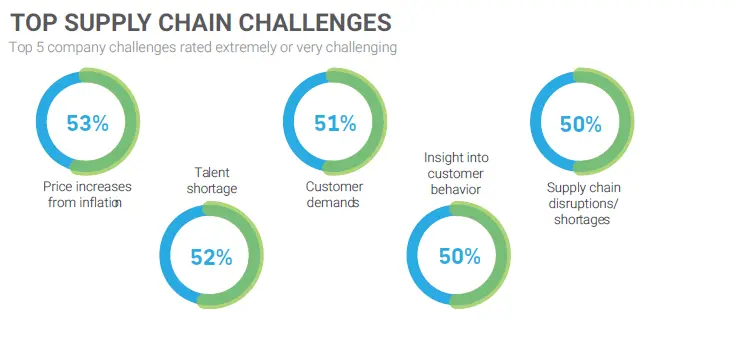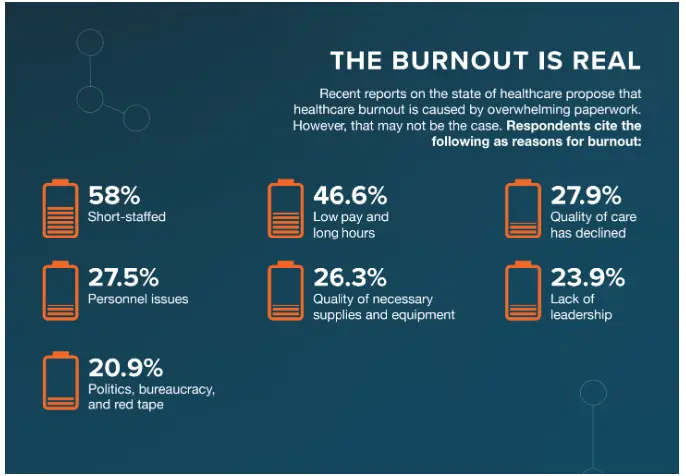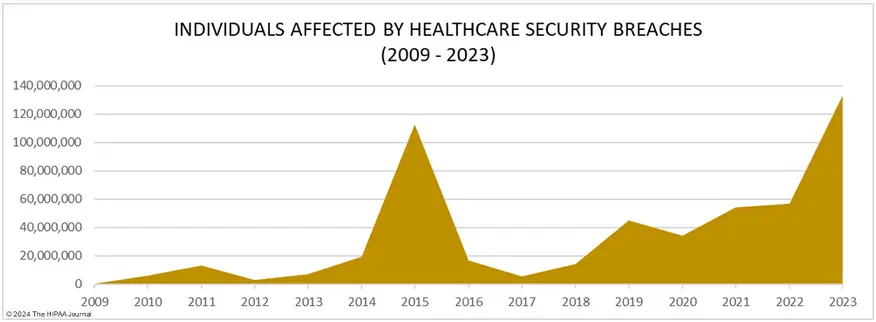As we inch closer to 2025, the “Great Logistics Divide” is creating a gap that may soon be too large to overcome, putting logistics companies that don’t adapt at a clear disadvantage.
According to recent research, 55% of supply chain leaders are increasing their technology and innovation investments, with 88% planning to spend over $1 million—and 42% aiming to invest more than $10 million. Companies positioned as digital leaders are reaping the benefits of advanced technology, customer-centric strategies, and collaborative ecosystems. Meanwhile, laggards struggle to maintain pace, often constrained by outdated practices and short-term thinking.
In this blog, we’ll explore the key metrics that differentiate leaders from laggards and examine the factors driving this divide in the race.
Top 5 Supply Chain Challenges
To better understand the pressures on the logistics industry, here’s a quick look at the top challenges that impact both leaders and laggards:

Source: MHI
These challenges illustrate why companies must move from traditional, reactive models to proactive digital strategies. Let’s explore how leaders and laggards address these critical areas differently and what sets leaders apart.
1. Technology Adoption
Technology adoption is a crucial factor distinguishing industry leaders from laggards. Digital leaders capitalize on advanced technologies such as artificial intelligence (AI), the Internet of Things (IoT), and blockchain, enabling real-time insights, predictive analytics, and streamlined supply chain processes once unimaginable.
- AI and Machine Learning help companies forecast demand patterns, optimize logistics, and accurately manage inventory.
- IoT Sensors provide real-time shipment visibility, reducing risks related to damage, loss, or delays.
- Blockchain enhances transaction transparency and security, which is vital in industries like pharmaceuticals for chain-of-custody verification.
With labor costs in logistics rising by up to 40% from 2018 to 2023, the need for automation and AI-driven solutions is critical to optimize workforce management and lower operational expenses. Laggards, however, are only beginning to explore these technologies and often struggle with operational disruptions and higher costs, putting them at risk of obsolescence.
2. Customer-Centric Approach
A defining characteristic of leaders is their customer-centric mindset. These companies integrate customer insights to offer a more personalized and responsive service. They create a competitive edge beyond cost savings by prioritizing end-user needs and tailoring services to meet them.
- Leaders understand that today’s customers expect fast, seamless, and transparent service. They use data analytics to forecast customer needs and proactively address potential issues.
- Some logistics leaders use augmented reality (AR) and virtual reality (VR) to streamline warehouse operations and enhance the customer experience through virtual tours or product previews.
Conversely, laggards focus solely on internal processes rather than customer satisfaction. This inward-focused approach limits their ability to build long-term customer loyalty and address market demands, leading to customer churn and missed opportunities.
3. Financial Performance and Investment
Digital leaders achieve more robust financial performance through a strategic approach to digital investment, focusing on long-term value rather than short-term savings. Their proactive approach includes the following:
- Higher Investment in Digitalization: Leaders prioritize innovation, scalability, and resilience as core components of their growth strategy.
- Efficiency and Cost Savings: Advanced solutions and customer insights help leaders cut costs, improve efficiency, and enhance service offerings, leading to greater profitability.
- Adaptability to Disruptions: Resilient systems better withstand economic shifts and unexpected disruptions.
This approach shows results: the highest-grossing companies in transportation and logistics increased productivity—measured by revenue per employee—by 15% from 2018 to 2023. Laggards, in contrast, adopt a short-term cost-cutting mindset, viewing digital investments as an expense. This often leads to inefficiencies, limiting their adaptability in a digital-first market.
4. Collaborative Ecosystems
Collaboration is at the heart of logistics leaders’ success. Digital leaders actively engage in cooperative networks that drive innovation and efficiency.
- Collaborative ecosystems enable leaders to share logistical burdens and co-develop solutions that benefit the entire value chain.
- These partnerships drive mutual value and allow companies to stay agile, responding to market changes and customer demands faster.
In contrast, laggards operate in silos, limiting collaboration opportunities and remaining disconnected from the broader ecosystem. This lack of synergy restricts their ability to adapt, innovate, and expand their market reach effectively.
5. Talent and Confidence: The People Edge
A skilled workforce is essential for driving innovation and sustaining digital initiatives. Due to ongoing training and strategic talent investments, leaders show high confidence in their workforce’s capabilities.
- Talent Development and Upskilling: Leaders prioritize equipping teams with the tools to manage and leverage emerging technologies.
- Culture of Innovation: By fostering an innovative culture, they encourage employees to think strategically, driving continual improvement.
However, turnover of logistics employees is up by 33% compared to pre-COVID-19 levels, illustrating the urgent need for effective talent management strategies, including training and development, to retain skilled workers in a competitive market. With minimal investment in upskilling, laggards face talent gaps that hinder digital transformation efforts and worsen operational inefficiencies.
The Road Ahead
As the logistics industry advances toward 2025, the divide between digital leaders and laggards is only widening. Leaders are setting themselves apart by embracing technology, prioritizing customer needs, building collaborative ecosystems, and investing in their talent.
For companies still on the sidelines, the message is clear: investing in digital transformation is no longer optional but essential. As challenges and opportunities continue to evolve, those willing to innovate and adapt will thrive, while those stuck in traditional methods risk being left behind. The time to act is now, ensuring your organization is not only prepared for 2025 but positioned to lead in the years to come.
















